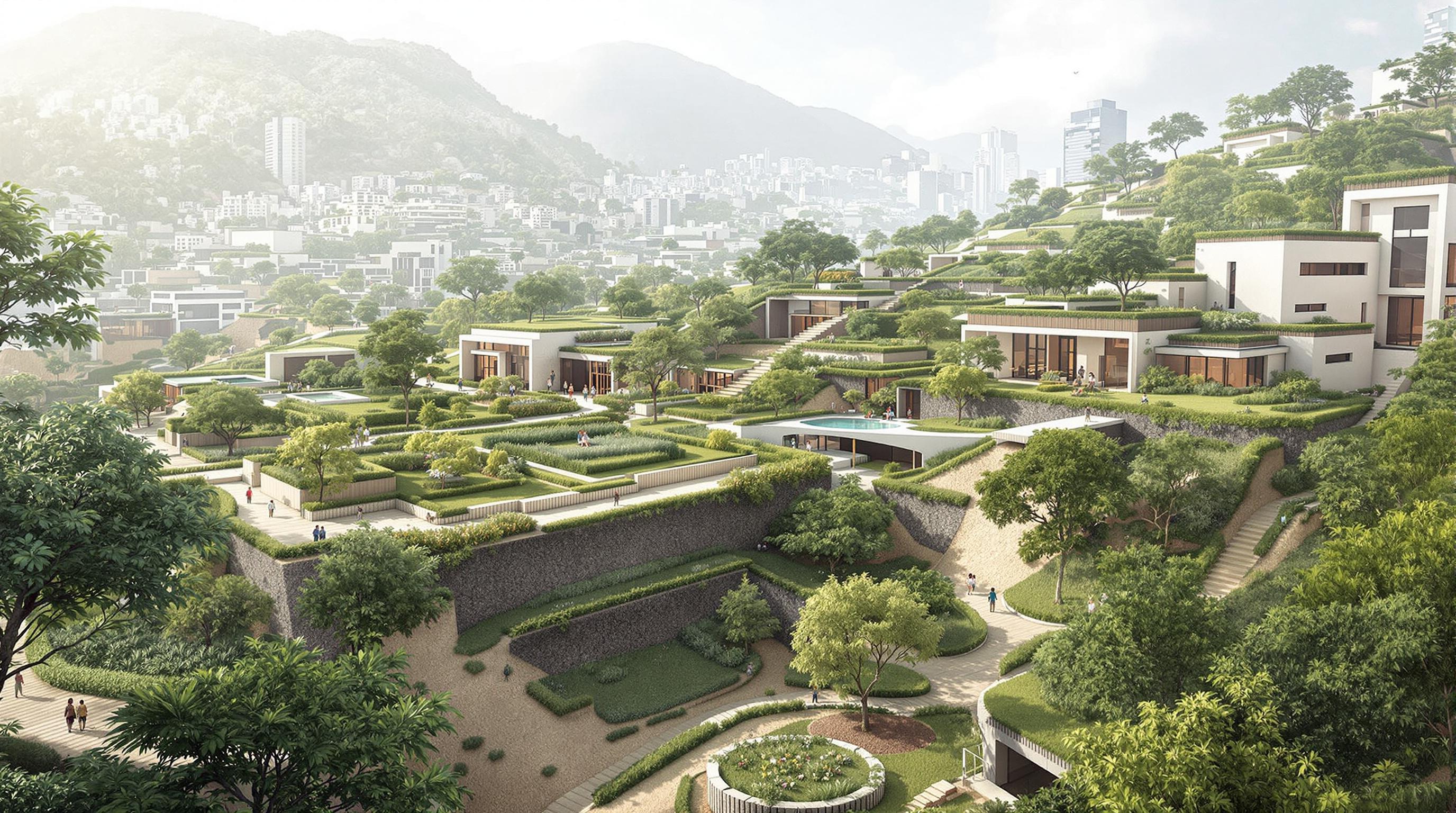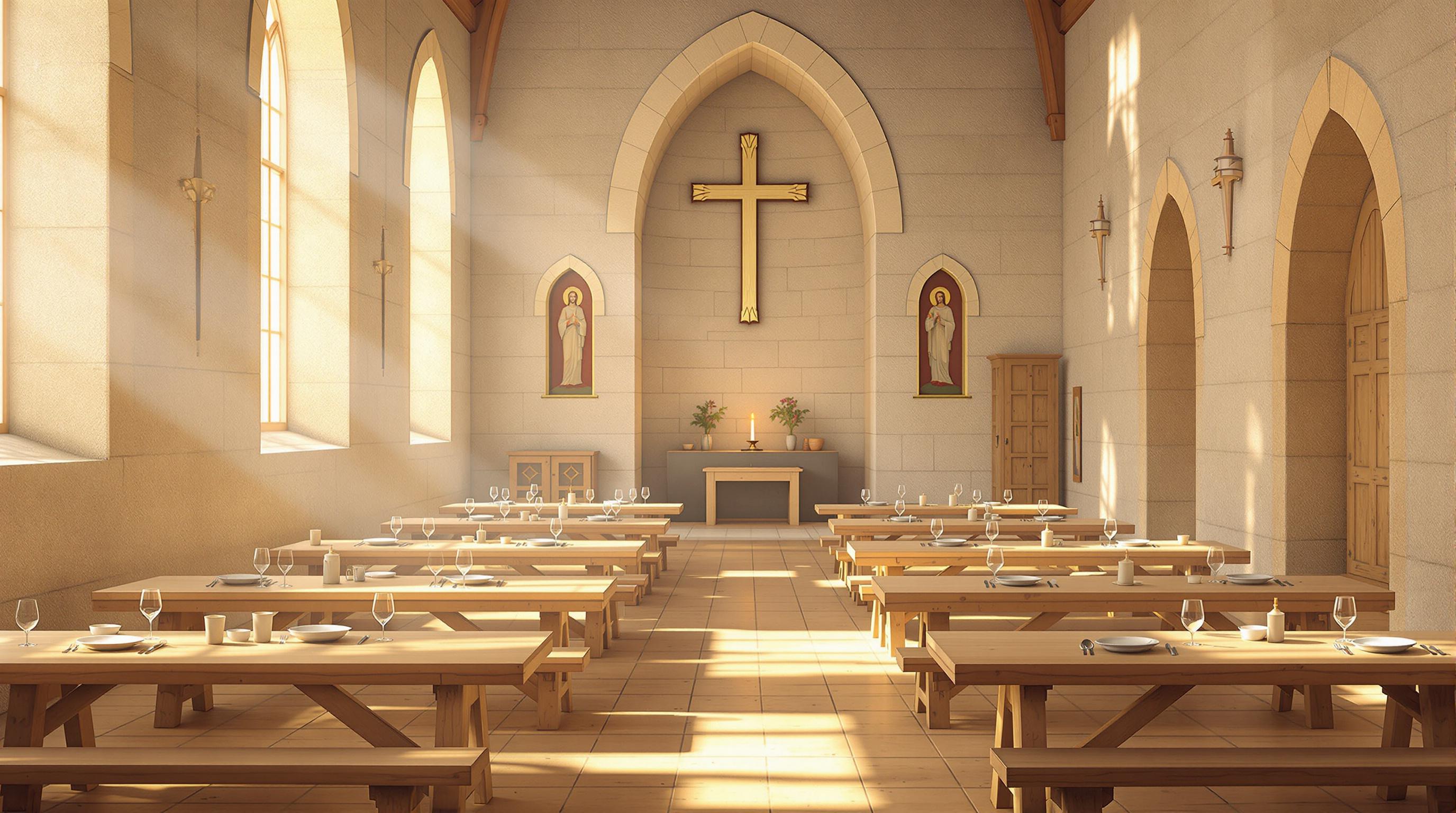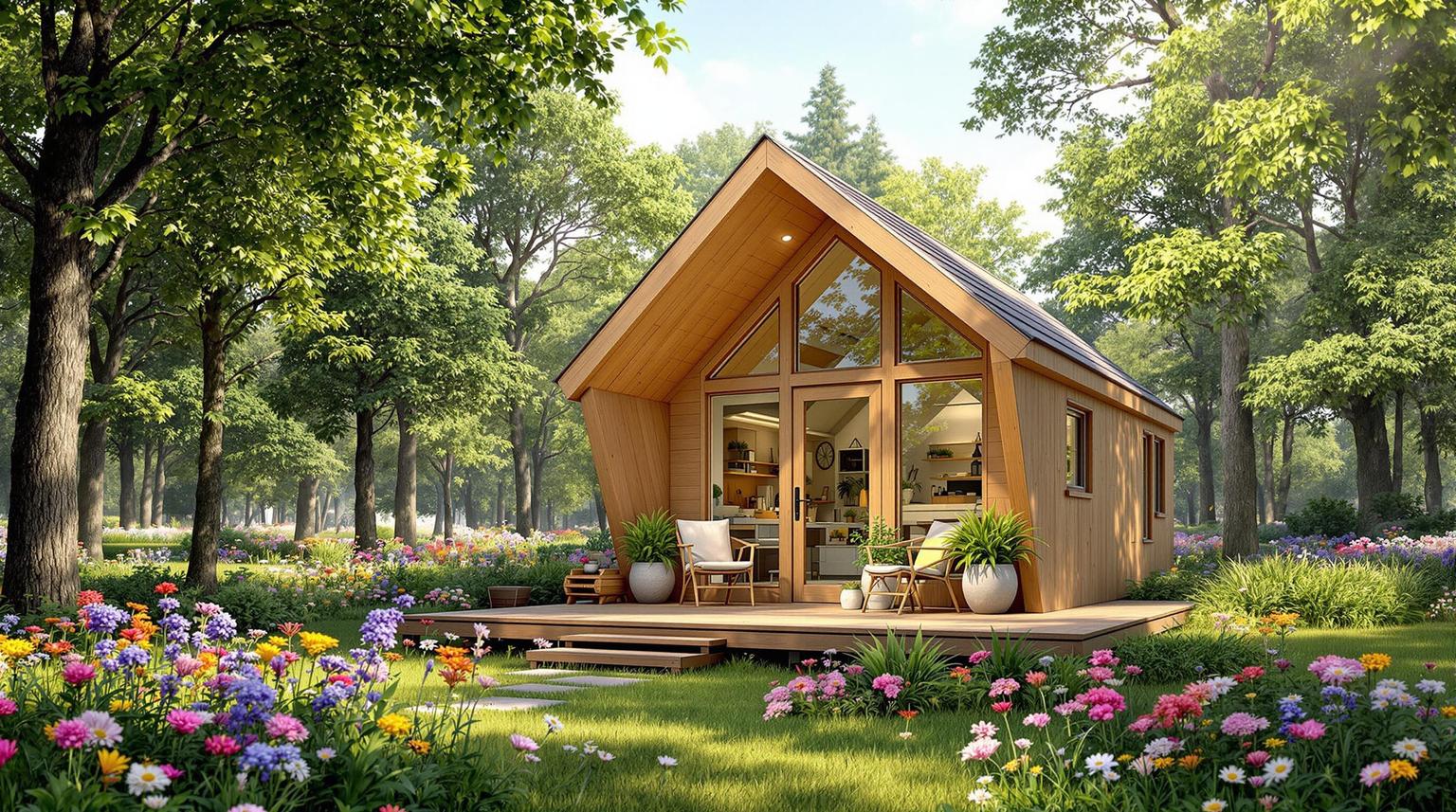The Hague boasts a mix of historic and modern architecture that showcases its role as a political and cultural center. Here's a quick rundown of 10 famous buildings:
- Binnenhof: 13th-century complex housing Dutch parliament
- Peace Palace: Home to International Court of Justice
- Mauritshuis: Museum with Dutch Golden Age masterpieces
- Noordeinde Palace: King's working palace
- The Hague Tower: Modern skyscraper with panoramic views
- Escher in Het Paleis: Museum dedicated to M.C. Escher's art
- Knight's Hall: Gothic hall for royal events
- Great Church of The Hague: 14th-century Gothic church
- The Hague Central Station: Glass-covered transport hub
- Nirwana Flat: Holland's first tower block
| Building | Era | Key Feature |
|---|---|---|
| Binnenhof | 13th century | Dutch parliament |
| Peace Palace | Early 20th century | International law |
| Mauritshuis | 17th century | Art museum |
| The Hague Tower | 21st century | Panoramic views |
| Nirwana Flat | Early 20th century | First Dutch high-rise |
These buildings reflect The Hague's evolution from medieval times to the present, blending political importance, cultural heritage, and modern urban development.
Related video from YouTube
The Binnenhof

The Binnenhof is the heart of Dutch politics in The Hague. This 13th-century complex houses the Dutch parliament and the Prime Minister's office.
What started as Count Floris IV's hunting lodge is now one of the world's oldest working parliament buildings. Its Gothic architecture and central courtyard tell a story of centuries-old Dutch governance.
Key spots in the Binnenhof:
- The Ridderzaal (Knight's Hall): Oldest part, used for the King's annual speech
- The Torentje (Little Tower): Prime Minister's office since 1982
- The House of Representatives: In a 1992 expansion, fits 150 members
The Binnenhof isn't just a building - it's a Top 100 Dutch heritage site and the stage for major national events. Every Prinsjesdag (Prince's Day), the King gives his Speech from the Throne in the Ridderzaal.
Right now, the Binnenhof is getting a facelift:
| What's Happening | Details |
|---|---|
| Cost | €475 million |
| How Long | About 5.5 years |
| Finish Date | 2028 (maybe later) |
| Started | September 2021 |
Because of this, you can't go into the inner court, and the government's working elsewhere in The Hague for now.
Want to learn more about Dutch politics and history? ProDemos used to offer tours, but with the renovations, it's best to check the official website for what's open and when.
The Binnenhof, with its Gothic and Renaissance mix, is still THE symbol of Dutch democracy and a must-see in The Hague.
2. Peace Palace
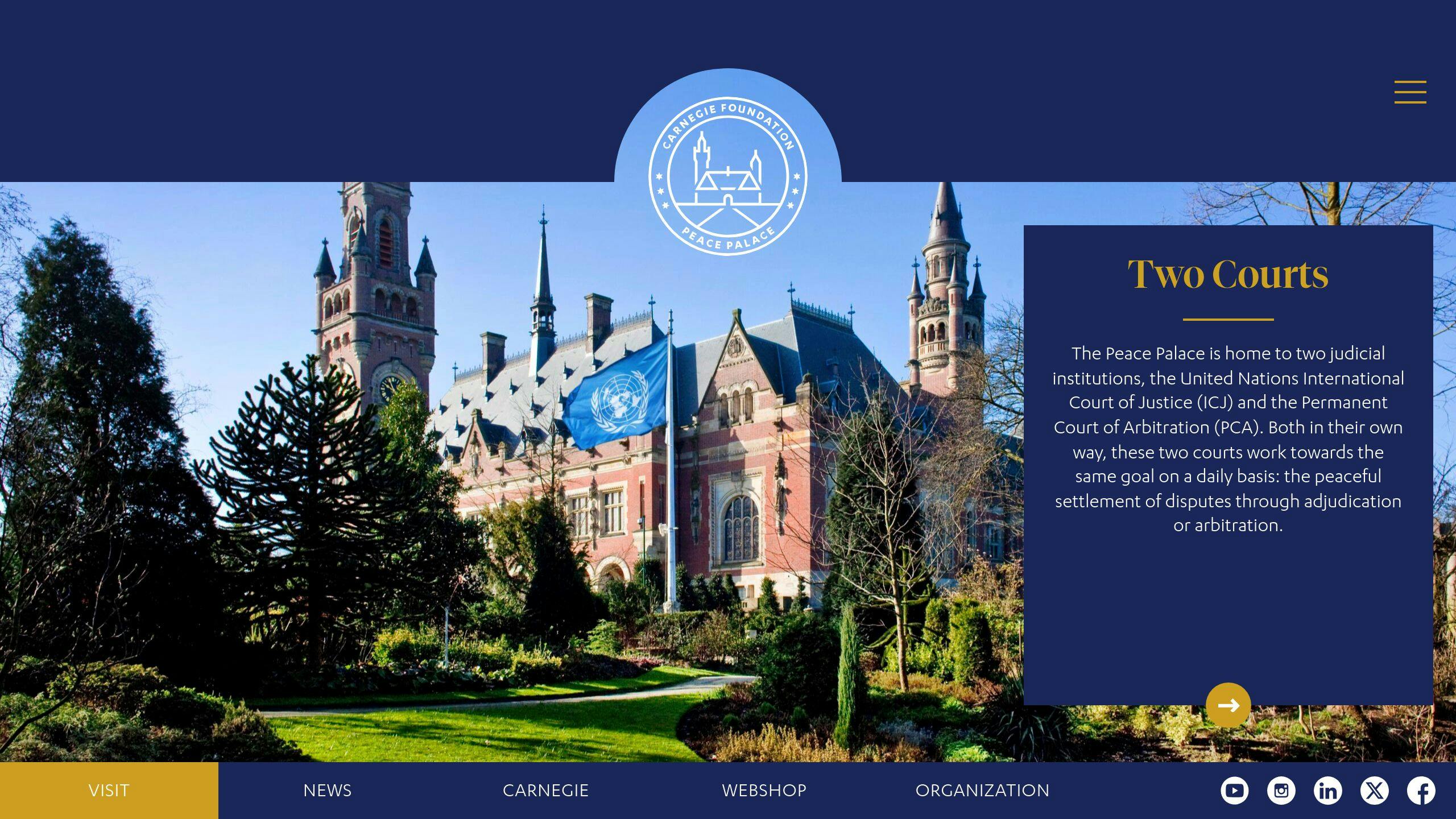
The Peace Palace isn't just a pretty building. It's where global justice happens.
Built in 1913, this Neo-Renaissance structure in The Hague is home to:
- International Court of Justice (ICJ)
- Permanent Court of Arbitration (PCA)
- The Hague Academy of International Law
- Peace Palace Library
Here's the kicker: Andrew Carnegie funded it. He dropped $1.5 million (that's about $50 million today) to make it happen.
| Quick Facts | |
|---|---|
| Built | 1907-1913 |
| Style | Neo-Renaissance |
| Cost | $1.5 million (1913) |
| Owner | Carnegie Foundation |
This place has seen some action. We're talking Nuremberg trials, Lockerbie bombing trial, and more. It's not just a building - it's where history happens.
Want to check it out? You can't roam free, but there's a visitor center. Sometimes they even do garden tours.
Andrew Dickson White said it best:
"A temple of peace where the doors are open, in contrast to the Janus-temple, in times of peace and closed in cases of war [...] as a worthy testimony of the people that, after many long centuries finally a court that has thrown open its doors for the peaceful settlement of differences between peoples."
The Peace Palace keeps up with the times, too. They've added LED lighting in the main courtroom. Old meets new, right? And in 2014, it got the European Heritage Label. That's a big deal.
3. Mauritshuis
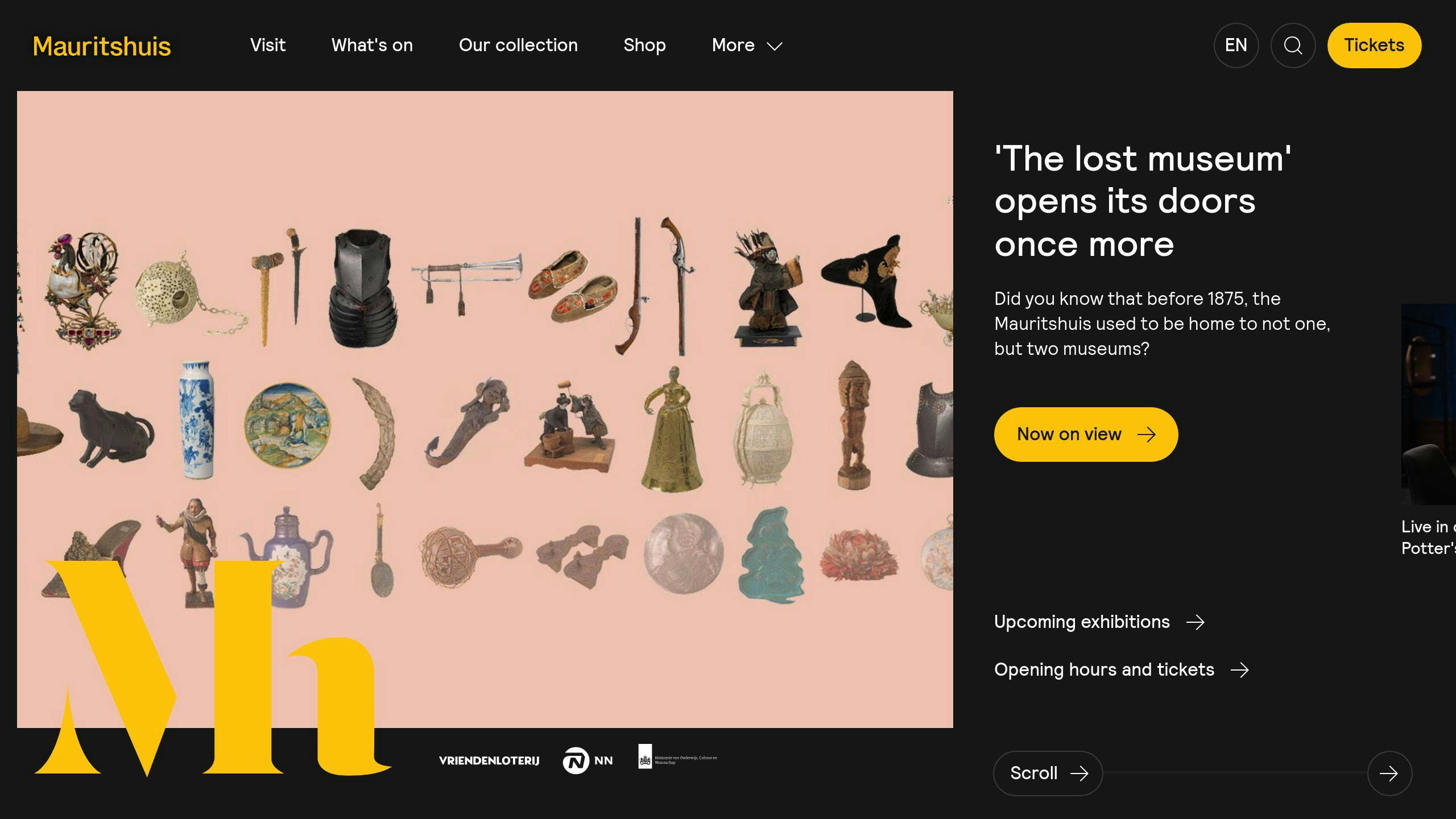
The Mauritshuis in The Hague isn't just a museum. It's a time machine to the Dutch Golden Age.
Built in the 1600s, this former noble residence now houses the Royal Cabinet of Paintings. It's been a public museum since 1822.
What's special about the Mauritshuis?
- It's Dutch classicism at its finest
- It's home to 854 objects, mostly Dutch Golden Age paintings
- You'll find Vermeer's "Girl with a Pearl Earring" and Rembrandt's "The Anatomy Lesson" here
| Quick Facts | |
|---|---|
| Built | 1636-1641 |
| Became a Museum | 1822 |
| Collection Size | 854 objects |
| Visitors (2018) | 416,334 |
The Mauritshuis is all about quality over quantity. With only 250 paintings on display, it's got one of the highest paintings-per-square-meter ratios in the Netherlands.
Don't miss:
- "The Goldfinch" by Carel Fabritius
- "Two African Men" by Rembrandt
- "Diana and her Nymphs" by Vermeer
After a big makeover in 2014, the museum reopened its doors. It's now run by a private foundation, blending old-world charm with modern management.
As Simone Hollen from the Mauritshuis says:
"The beauty of the Mauritshuis is in its history and its artworks. Even if you aren't an art lover, you'll still have a special experience."
Art fan or not, the Mauritshuis offers a slice of Dutch history you won't forget.
4. Noordeinde Palace

Noordeinde Palace isn't just another pretty building in The Hague. It's where the Dutch King gets stuff done.
| Quick Facts | |
|---|---|
| Built | 1640 |
| Style | Dutch Classicism |
| Use | King's office |
| Public Access | Gardens only |
This place has come a long way from its humble beginnings as a farmhouse in 1533. Prince Frederik Hendrik gave it a major glow-up, turning it into the grand palace we see today.
Every Wednesday, there's a bit of pomp and circumstance when new ambassadors show up. Picture this:
Drum rolls, national anthems, and the King inspecting the guard. It's like a mini-parade, royal style.
Can't peek inside? No worries. The area around the palace is worth exploring:
- Palace Gardens: Open from sunrise to sunset
- Noordeinde district: Shop 'til you drop or get your art fix
The palace has seen its fair share of royal drama:
- Weddings? Check.
- Lying in state of royals? Yep, that too.
Want to catch a royal sighting? Mark your calendar for Prinsjesdag. That's when the King rides from Noordeinde to Parliament in a fancy coach. It's as close to a real-life fairy tale as you're gonna get.
5. The Hague Tower
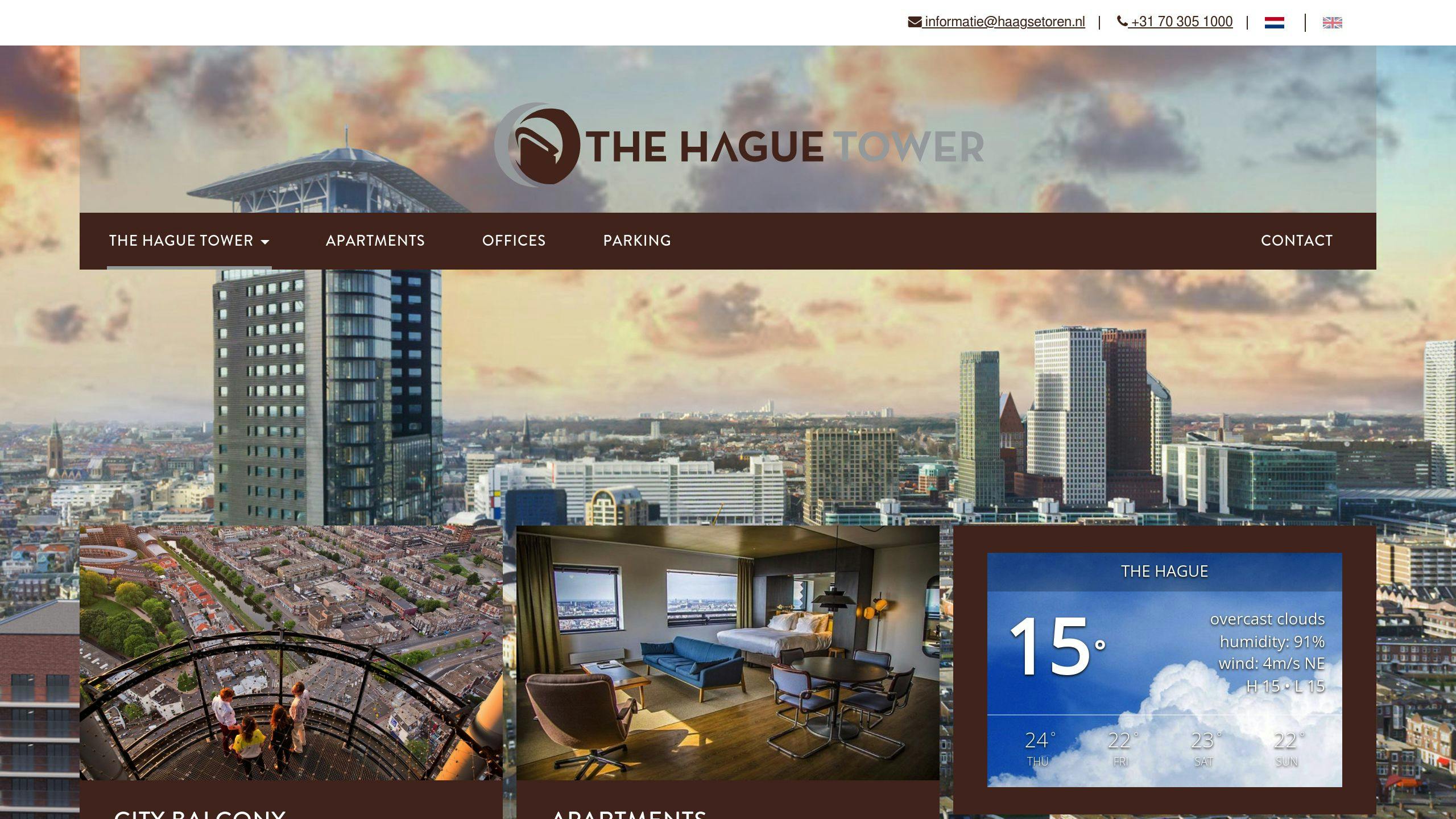
The Hague Tower, or Het Strijkijzer, is a 132-meter (433 ft) skyscraper that's become a city landmark since 2007. It's a mix of homes and offices, with a design that nods to New York's Flatiron Building.
| Quick Facts | |
|---|---|
| Height | 132 meters (433 ft) |
| Floors | 42 |
| Completed | 2007 |
| Awards | Hague New City Prize, Emporis Skyscraper Award (2007) |
Inside, you'll find 300 studio flats, 51 luxury apartments, office spaces, and The Penthouse restaurant - the highest in Holland.
But the real star? The 42nd-floor panoramic terrace. On a clear day, you can see Amsterdam Schiphol Airport's control tower and ships on the North Sea.
To get to the top:
- Ride the Panorama Elevator (40 seconds)
- Grab a drink at the SkyBar
- Step out for the views
"It's totally a must. Good to know, if you go for a drink at the Sky Bar (6 Euros), you will have access to the outside. Well worth it!" - Anonymous Visitor
Tip: Sunset offers the best views. Wear flat shoes for the outdoor area.
The Hague Tower isn't just eye-catching. It's a smart answer to city living, packing homes, offices, and sky-high views into one sleek package.
sbb-itb-1be9014
6. Escher in Het Paleis

Ever wanted to step into a world where stairs go nowhere and birds morph into landscapes? Welcome to Escher in Het Paleis, The Hague's mind-bending museum.
Housed in an old royal palace, this place is a trip. It's packed with over 150 of M.C. Escher's prints, including some real head-scratchers:
- "Day and Night" (1938): Dutch fields turn into birds. Seriously.
- "Relativity" (1953): Stairs that'll make you question gravity.
- "Metamorphosis III" (1967-1968): A massive 7-meter woodcut. It's wild.
The museum's spread across three floors:
1. Ground floor: Escher's early stuff.
2. Second floor: The optical illusions that'll mess with your brain.
3. Third floor: Get hands-on with some modern mind-benders.
| Quick Facts | |
|---|---|
| Opened | November 15, 2002 |
| Annual Visitors | 150,000 |
| Director | Margriet Schavemaker |
| Curator | Judith Kadee |
Want to feel like you're in an Escher print? Try building the "Impossible Penrose Triangle" on the second floor. Good luck with that.
Hungry? Hit up the MC Cafe in the old royal kitchen. Fancy.
Here's the deal on tickets:
| Category | Price |
|---|---|
| Adults | €10 |
| Teens/Students | Reduced rate |
| Children under 6 | Free |
| Families | €24.50 |
Open Tuesday to Sunday, 11 am to 5 pm. Closed Mondays.
Pro tips:
- Book online. Skip the line.
- Go on a weekday afternoon. Less crowded.
- Take your time. This isn't a race.
Escher in Het Paleis isn't just some stuffy art museum. It's a journey through Escher's wild imagination. From intricate woodcuts to mind-bending tessellations, you'll see how this guy went from "huh?" to "whoa!" and changed the game in art and math.
7. Knight's Hall

The Knight's Hall, or Ridderzaal, is a Gothic gem in The Hague's Binnenhof complex. Built in the 13th century, it's been at the heart of Dutch history for 800 years.
Why is it special? It's HUGE. At 40 by 20 meters, it hosts royal events. Look up and you'll see 18-meter-long beams forming a roof that looks like an upside-down ship. Don't miss the rose window with Dutch noble family crests.
This hall's seen some action:
| Year | Event |
|---|---|
| 1581 | States General rejected King Philip of Spain |
| 1948 | Congress of Europe discussed European integration |
| 1949 | Dutch-Indonesian Round Table Conference held |
Now, it's where the Dutch monarch gives the annual Speech from the Throne. But it wasn't always so fancy. It's been a veggie market, a hospital ward, and even housed lottery offices!
In 1904, the Knight's Hall got a neo-Gothic makeover. Now it's got 19 wall hangings showing Dutch provincial arms and the first article of the 1848 Constitution painted on the chimney.
Want to visit? Check ahead - it's often closed for official business. When you go, look for the wooden heads on the ceiling beams. They're not just decor - they're meant to keep assembly members honest!
8. Great Church of The Hague
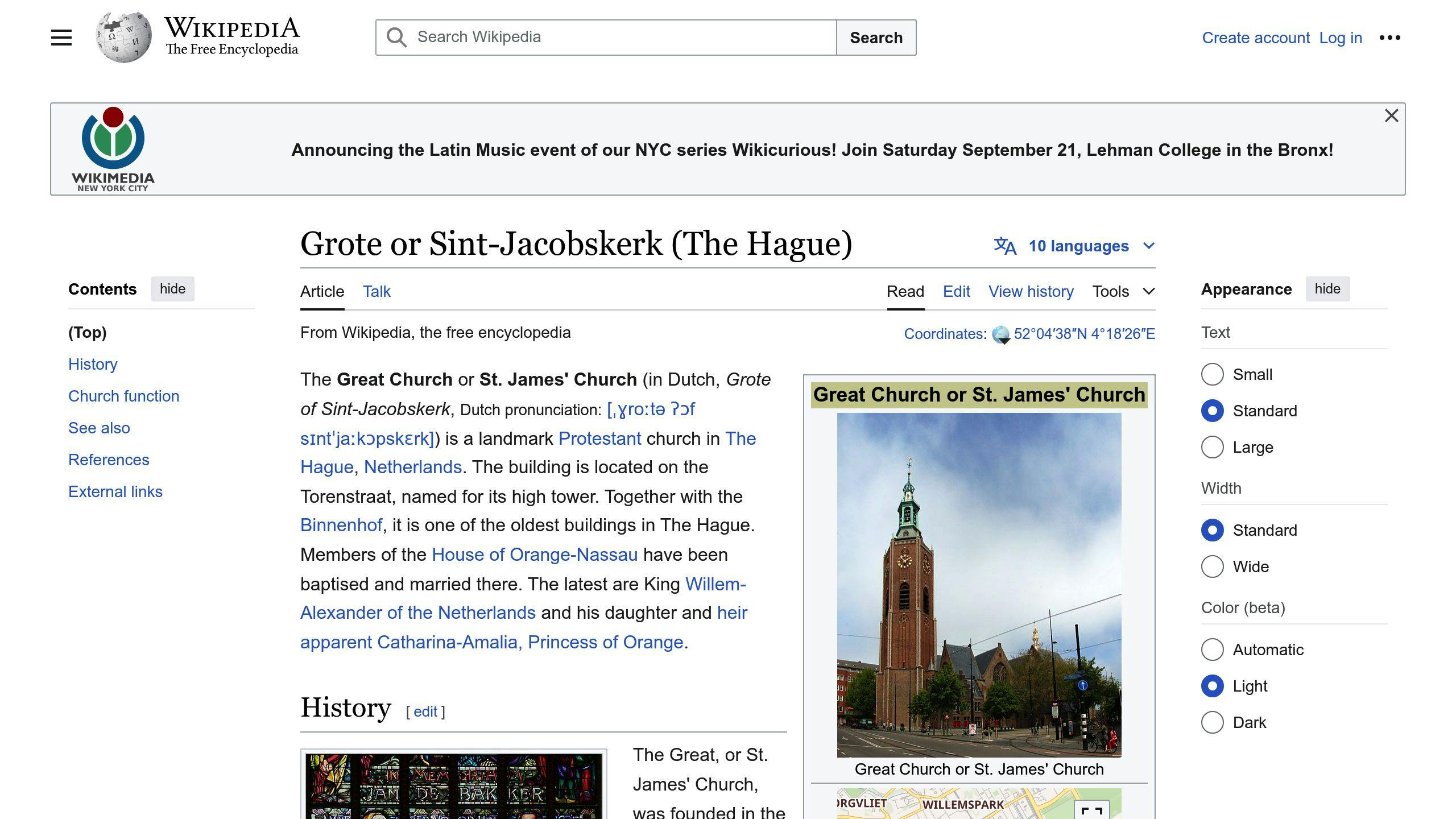
The Great Church of The Hague (aka St. James Church or Grote Kerk) is a Gothic giant that's been around since the 14th century. It's not just a pretty face - this church has seen its fair share of royal drama and Dutch history.
Here's what makes it special:
- A 304-foot tower that's been pointing to the sky since 1424
- Stained glass windows that tell stories (some even feature Dutch royals)
- Four massive bells with cool names: Jacob, Jhezus, Salvator, and Wege Waert
The church got a makeover between 1434 and 1455. They ditched the cross shape and went for a hall-style look. Why? Who knows, but it sure looks good.
Now, let's talk royals. This church has hosted some big-time events:
| Event | Date | Royal VIPs |
|---|---|---|
| Baby christening | June 12, 2004 | Princess Catharina-Amalia |
| Wedding | February 7, 1901 | Queen Wilhelmina & Duke Heinrich |
| Wedding | February 2002 | King Willem Alexander & Queen Maxima |
These days, the Great Church is more of a cultural hotspot than a place of worship. It stopped regular services in 1982 and now hosts concerts, exhibitions, and even the Speech from the Throne (thanks, COVID).
Want to check it out? Here's what you need to know:
- It's only open sometimes (check before you go)
- The tower's off-limits for now
- You'll need to pay to get in
It's smack in the middle of The Hague, near the Spuistraat shopping street. Perfect for a quick history fix between shopping sprees.
"A Gothic architecture masterpiece a historic church with a tall nice looking tower that adds to the area." - George, Nicosia, Cyprus
The Great Church of The Hague: where old-school cool meets modern-day culture.
9. The Hague Central Station
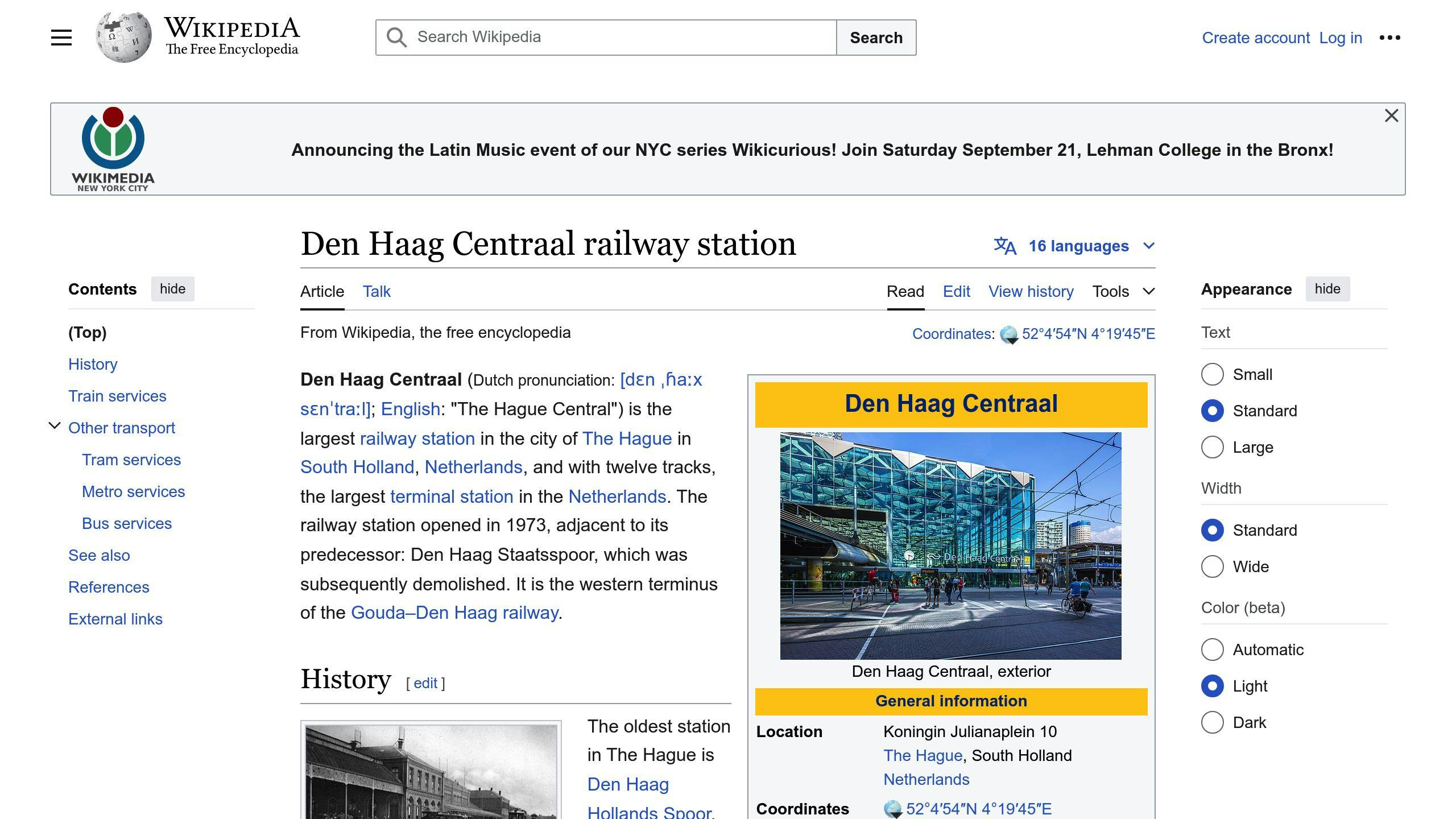
The Hague Central Station isn't just a train stop. It's a glass giant that's become a city landmark since 2016.
Here's what makes it cool:
- It's BIG: 120m long, 96m wide, 22m high
- It's see-through: Almost all glass
- It's shiny: 218 diamond-shaped glass panels on the roof
But it's not just a pretty face. This station works hard:
| Feature | Numbers |
|---|---|
| Daily passengers | 190,000 (might double soon) |
| Platforms | 7 |
| Tracks | 12 |
| Shops and cafes | 3,816 m² |
The station's smart design makes life easier for travelers. It has four entrances and links the city center to the financial district. Plus, it's a transport hub for trains, trams, and buses.
Sharon Dijksma, a government official, called it:
"A railway station of glass, a cathedral of light."
She's spot on. The glass isn't just for looks. It lets in sunlight and helps people find their way around.
Next time you're in The Hague, don't just rush through. Look up and around. You might find yourself admiring one of the city's coolest new buildings.
10. Nirwana Flat
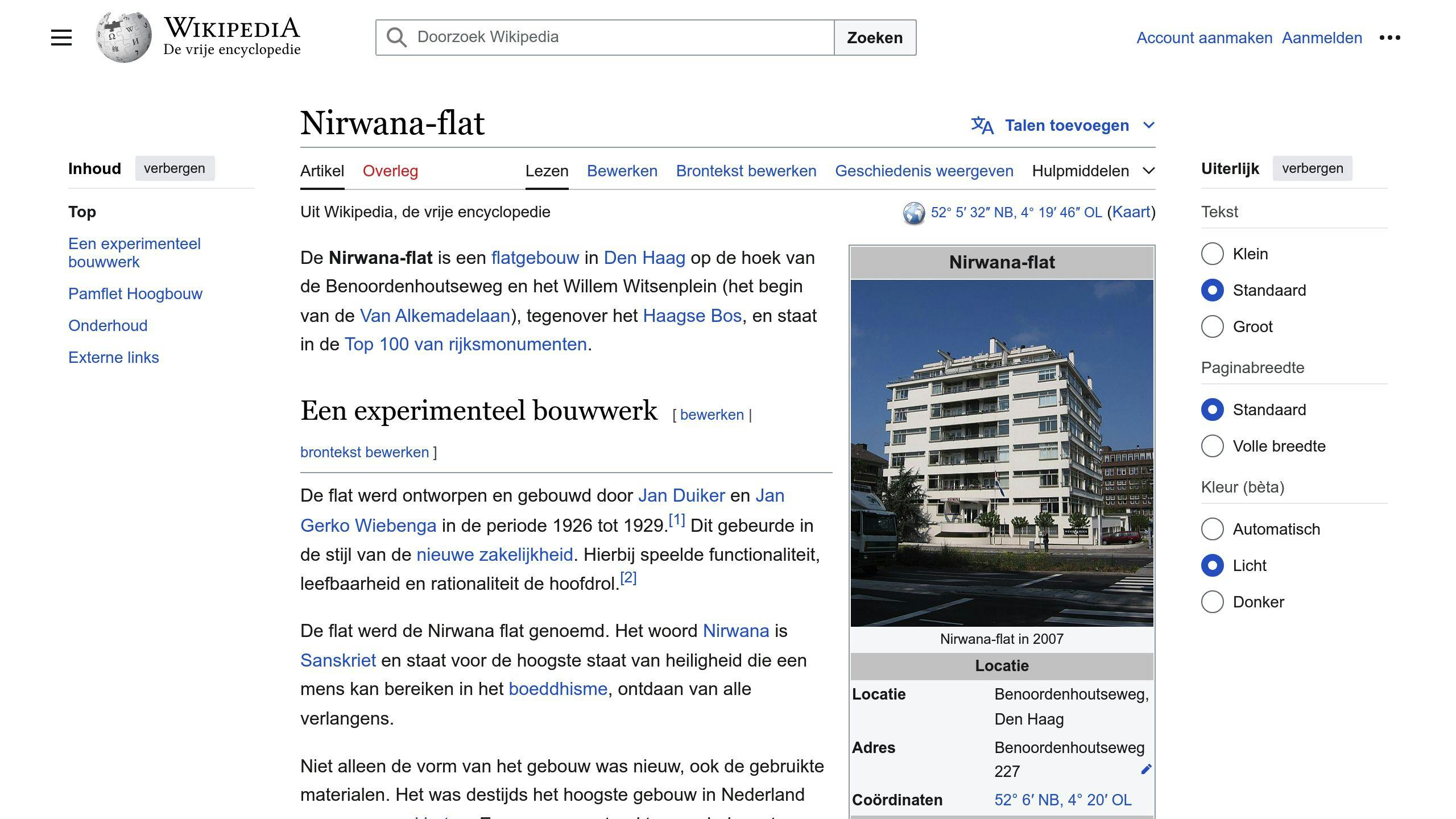
The Nirwana Flat in The Hague is Holland's first tower block. Built from 1927 to 1929, it was designed by Jan Duiker and Jan Gerko Wiebenga.
This high-rise sits at Benoordenhoutseweg and Willem Witsenplein, facing the Haagse Bos. It's special because:
- It's the first Dutch high-rise with a concrete frame
- It has unbroken window bands
- There are projecting balconies on its west corner
When built, it was the Netherlands' tallest concrete building. The architects wanted to solve housing problems with high-rise living.
The Nirwana Flat had modern features for its time:
| Feature | Description |
|---|---|
| Phones | For communication |
| Waste chutes | For garbage disposal |
| Central heating | For temperature control |
| Central kitchen | With goods lift delivery |
But it wasn't all smooth sailing. The city stopped plans to double its height. And it had some issues:
- Thin walls (only 15 cm)
- Cracks and leaks
- Rusting steel structure
They fixed these problems with restorations in 1991/92 and 2003.
At first, people weren't sure about the Nirwana Flat. Now? It's one of The Hague's most wanted addresses. Its roomy, comfy homes are in high demand.
The Nirwana Flat is now a national monument, part of the Top 100 rijksmonuments. Its design focuses on function, livability, and logic - typical of the new objectivity style.
From its Sanskrit name to its Art Deco touches, the Nirwana Flat is a key part of The Hague's architectural history and urban living innovation.
Wrap-up
The Hague's buildings tell a story. From old castles to new skyscrapers, they show how the city has changed over time.
Here's a quick look at The Hague's architecture through the years:
| Era | Style | Examples |
|---|---|---|
| 13th Century | Medieval | Binnenhof, Ridderzaal |
| 17th Century | Dutch Golden Age | Mauritshuis, Huis ten Bosch |
| Early 20th Century | Modernism | Nirwana Flat |
| Late 20th Century | Contemporary | City Hall |
| 21st Century | Sustainable | The Hague Tower |
The Binnenhof, from the 13th century, is where Dutch politicians work today. It's like a bridge between old and new.
The Peace Palace, built in 1913, made The Hague famous for international law. It's why people call the city the "International City of Peace and Justice."
The Mauritshuis, from the 17th century, now holds famous art. It's where you can see the "Girl with a Pearl Earring" painting.
New buildings, like the City Hall, show The Hague isn't stuck in the past. It has lots of glass and a simple design - very different from old Dutch buildings.
The Nirwana Flat was Holland's first tall apartment building. Built in the late 1920s, it was a new way to give people homes in the city.
Today, The Hague mixes old and new in its buildings. New projects often use ideas from old buildings but add modern touches.
The Hague's buildings aren't just nice to look at. They show what Dutch people care about. Old houses have big windows for lots of light. New buildings focus on being good for the environment.
As The Hague grows, its buildings will keep changing. But the city will always remember its history as it looks to the future.
